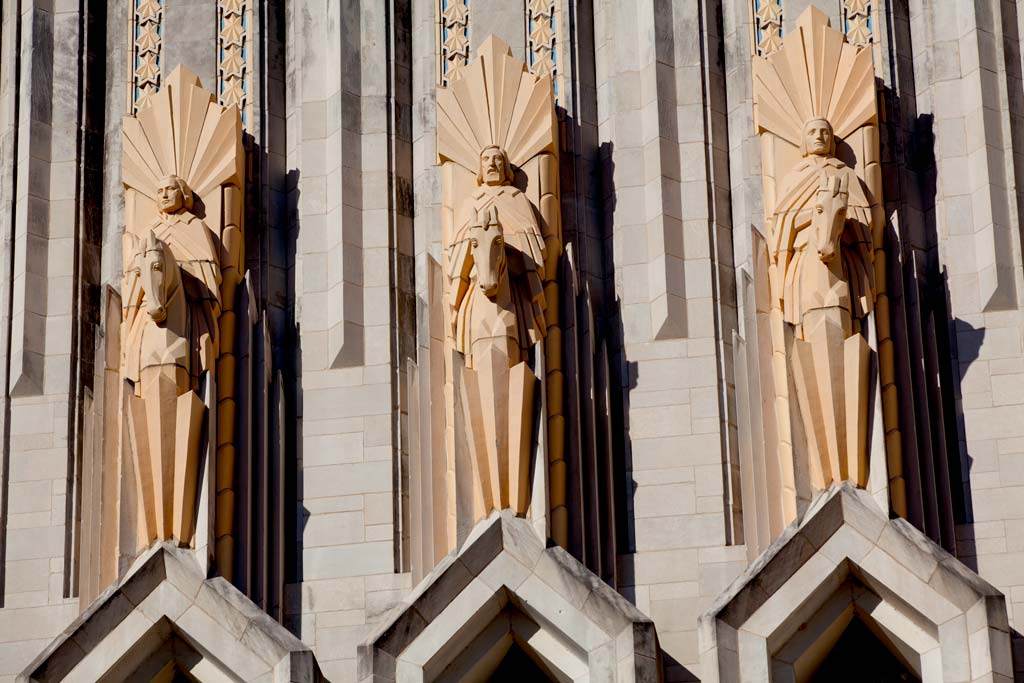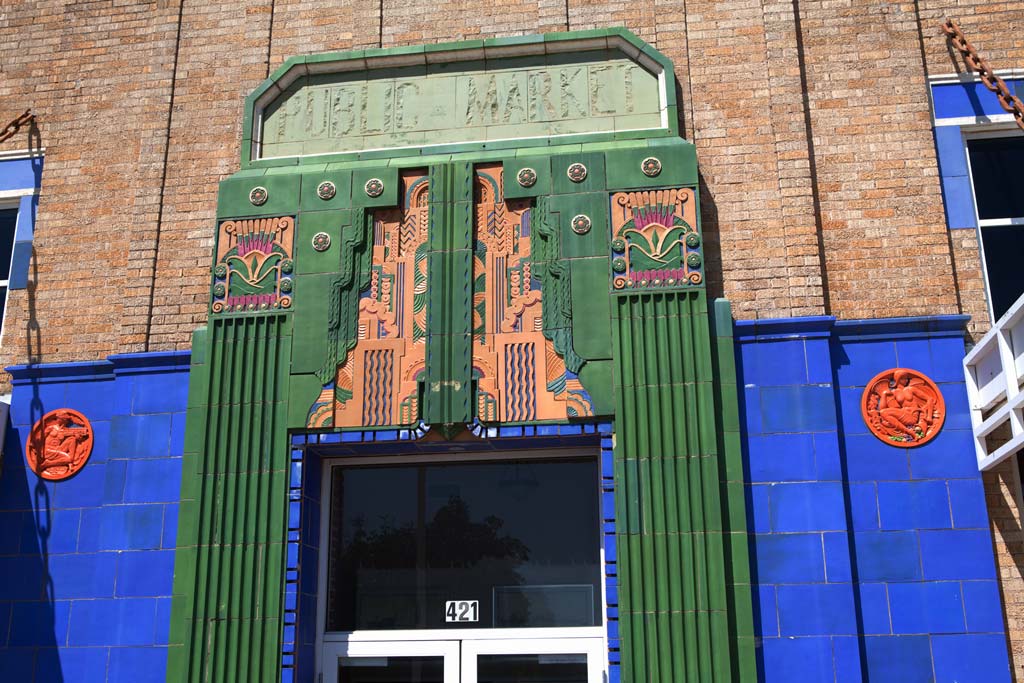
Over my years of writing about Oklahoma music, I’ve gotten into a lot of conversations about the exceptional quality of Tulsa’s musicians. Often, they’ve led to a question: Is Tulsa really something special, or does every city of any size have its own unique sound and musical legacy?
Despite all the examples to support Tulsa’s standout contributions to the popular-music scene, the evidence ends up far more qualitative than quantitative; that is, it’s impossible to calculate just exactly how much noteworthy Tulsa music has been made over the years, especially in comparison to what’s been created in other cities. It just can’t be measured that way.
There is, however, an art form that can: Art Deco, that striking decorative style from the 1920s and ’30s. And, according to the new book Art Deco Tulsa (History Press) and its author, the veteran writer and editor Suzanne Fitzgerald Wallis, Tulsa is exactly the third-best place in the country to find still-standing Deco architecture.
“Suzanne writes a lot in the book about the position Tulsa holds in the world of Art Deco,” says Sam Joyner, an award-winning photographer who shot the pictures for Art Deco Tulsa. “Most people don’t know it, but there’s New York, there’s Miami [Florida] – and then there’s Tulsa.”
Joyner and Wallis spent much of the past couple of years tracking down as many examples of the style – or, actually, the three styles, as we’ll see in a moment – as they could find around the city. Some, like Boston Avenue Methodist Church, the Mid-Continent Tower and the Union Depot, are well-known examples. Others are less well-known. And some, unfortunately, are long gone, with little indication that they ever existed.
“Tulsa was at one time called Terra Cotta City,” says Wallis, referring to the clay-based material used extensively in Art Deco buildings. “We had the highest density of Art Deco buildings per mile as any city in the States. In the ’60s, they started being torn down for new, modern buildings. Fortunately, people stepped forward and said, ‘Stop,’ so we still have many Art Deco buildings. I put together a chart of all the ones built in Tulsa, which of the three styles each one is in, who the architect was, its status and its address. That’s in the back of the book.”
In the rest of Art Deco Tulsa, she adds, “We talk about the history of Tulsa, define what Art Deco is, and talk about risk-takers, two of whom I’m particularly interested in: [famed oilman] Waite Phillips and Bruce Alonzo Goff, who is my very favorite architect. The whole thing began with risk-takers like these men. Then there’s a part about Terra Cotta City, a description of the three styles of Art Deco, and a section on lost and found buildings and people.”
Those styles, according to Wallis, are zigzag, streamline and PWA; the last stands for the Public Works Administration, a federal government project that gave architects, builders and construction workers much-needed employment during the Great Depression.

Photos by Sam Joyner
“The Boston Avenue Methodist building is zigzag,” Wallis says. “Zigzag had color. It was real jazzy – exotic, decorative art. Zigzag’s effect was to make buildings look tall, like they were soaring up into the sky. It was colorful; it was ornamental; it went right along with the Jazz Age [of the 1920s]. ‘The war’s over; we’re celebrating; everything’s great.’ That was zigzag.”
Photographer Joyner says, “The best way to look at streamline is to see some examples, like the City Veterinary Hospital out on Peoria [Avenue], which has all those glass bricks. Phoenix Cleaners is another one.
“And then the Public Works Administration buildings are pretty obvious. The Union Depot is the best example. It’s massive.”
Wallis agrees: “It is. The intent was to show that things could stay in place – that they were solid, strong, permanent.”
Nothing, of course, is really permanent. But some things survive longer than others, and Wallis and Joyner are vitally interested in not only preserving what’s left of the city’s Art Deco architecture, but also helping stoke the revival of interest in the form. Wallis has seen this happen before; books written by her husband, Michael Wallis, who contributed Art Deco Tulsa’s introduction, have been widely credited with sparking renewed interest in the highway once known as America’s Main Street. (With Michael, Suzanne co-edited 1993’s Greetings from the Mother Road: Route 66 Postcards and co-authored the 1996 collection Song Dog Diary: 66 Stories from the Road.) Like Route 66, Art Deco went through a good long period where, if not exactly forgotten, it was taken for granted or overlooked.
“With Suzanne, I got focused on where Deco went,” Joyner says. “My premise, and I think there’s a lot of truth to it, is that [influential architect] Walter Gropius and his Bauhaus School in Germany emphasized efficiency and function over form and beauty, and as a result we ended up with what I would call boring architecture, with no ornamentation. That’s what killed Deco.”
It may not, however, be that dead after all. Joyner and Wallis point to the MTTA Station in downtown Tulsa and Myers-Duren Harley-Davidson in Brookside as examples of Art Deco “beginning to come back.” There’s also Decopolis, a downtown store emphasizing Deco art owned by William Franklin, who, Wallis says, “has been working very hard to get an Art Deco museum in Tulsa.”
“Right now,” she says, “there’s Art Deco on display in the windows of the Philcade Building downtown. It’s an Art Deco building, and when you go into the lobby, the windows have displays of Deco items. The inside is just incredible.”
Wallis gives credit to many other Oklahoma-based advocates, including the now-deceased architects Herb Fritz and Rex Ball, for keeping Art Deco in the local public eye over the years.
“Herb Fritz was the one who saved the Tulsa Fire Alarm Building, and before he passed away he had put together a whole architectural plan to follow to save the Spotlight Theatre, one of our great Art Deco buildings that was an early creation of Bruce Goff,” she says. “Rex Ball had a conference on Art Deco here, and one of the points that was being made – and that we keep trying to make – was that Deco can be as much of an economic boon to the city as oil and gas were, thanks to the resurgence of interest in it. If we had an Art Deco museum, for example, people would come from all over the world to see it. It would be a real draw.”
Perhaps Art Deco Tulsa will end up as a catalyst for such an institution. Meanwhile, there’s plenty for Deco fans to appreciate between its covers.
“The celebration and enjoyment of the Deco itself – that’s one of the purposes of the book,” Joyner says. “Art Deco is absolutely gorgeous, and we want to convey that. But it’s not a coffee-table book. There’s tons of historical text, and I think the photography is there to help illustrate and support that. Suzanne does a great job of giving that historical perspective, when it was done and who the principal parties were.”
For his part, Joyner snapped some 500 photos, 144 of which ended up in the book.
“The aesthetics of these places were a lot stronger than I ever imagined,” he says. “You spend time with them, and you have a much greater appreciation for what an incredible treasure they are. I was thrilled when Suzanne gave me this opportunity – No. 1, because I was able to spend time with her, and No. 2, because I got to see all this Deco.”























